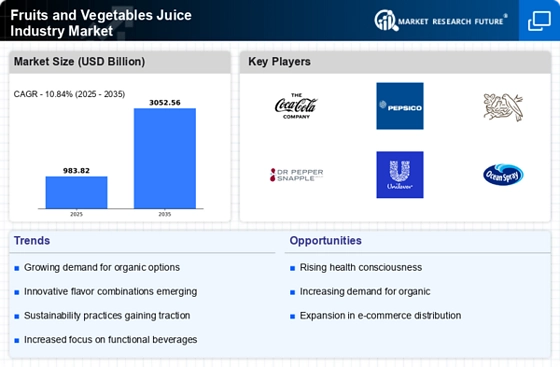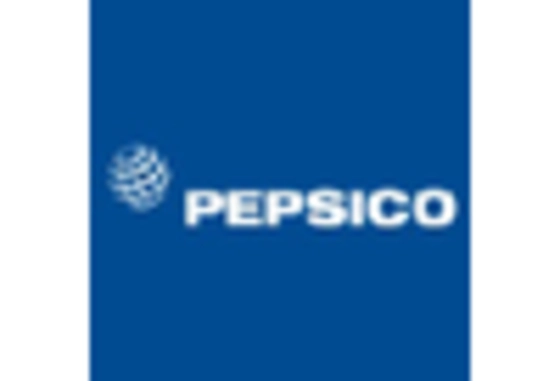Rising Health Consciousness
The Fruits and Vegetables Juice Industry Market appears to be experiencing a surge in demand driven by increasing health consciousness among consumers. As individuals become more aware of the nutritional benefits associated with fruits and vegetables, the preference for natural juices over sugary beverages intensifies. Recent data indicates that the market for fruit and vegetable juices is projected to grow at a compound annual growth rate of approximately 5.5% over the next five years. This trend suggests that consumers are actively seeking healthier alternatives, thereby propelling the Fruits and Vegetables Juice Industry Market forward. Furthermore, the emphasis on organic and cold-pressed juices reflects a shift towards premium products, which may further enhance market growth.
Innovative Flavor Combinations
Innovation within the Fruits and Vegetables Juice Industry Market is manifesting through the introduction of unique flavor combinations that appeal to adventurous consumers. Manufacturers are increasingly experimenting with blends that incorporate exotic fruits and vegetables, as well as functional ingredients such as superfoods and adaptogens. This trend is indicative of a broader consumer desire for novel experiences in their beverage choices. Data suggests that products featuring innovative flavors are gaining traction, with a notable increase in sales for juices that combine traditional ingredients with unexpected pairings. This innovation not only attracts new customers but also retains existing ones, thereby contributing to the growth of the Fruits and Vegetables Juice Industry Market.
Sustainability and Ethical Sourcing
Sustainability initiatives are becoming a pivotal driver in the Fruits and Vegetables Juice Industry Market. Consumers are increasingly prioritizing products that are ethically sourced and environmentally friendly. This shift is prompting manufacturers to adopt sustainable practices, such as using organic ingredients and eco-friendly packaging. Recent surveys indicate that a significant portion of consumers is willing to pay a premium for sustainably produced juices. This trend suggests that the Fruits and Vegetables Juice Industry Market is likely to see a rise in demand for products that align with consumers' values regarding environmental responsibility. As sustainability becomes a key differentiator, brands that embrace these practices may gain a competitive edge.
Convenience and On-the-Go Consumption
The Fruits and Vegetables Juice Industry Market is likely benefiting from the growing trend of convenience and on-the-go consumption. As lifestyles become increasingly hectic, consumers are seeking quick and easy nutritional options. Ready-to-drink fruit and vegetable juices cater to this demand, providing a portable source of vitamins and minerals. Market analysis reveals that the convenience segment is expected to account for a substantial share of the overall market, with a projected increase in sales of single-serve packaging. This shift towards convenience not only enhances accessibility but also aligns with the busy schedules of modern consumers, thereby driving the Fruits and Vegetables Juice Industry Market.
Growing Demand for Functional Beverages
The Fruits and Vegetables Juice Industry Market is witnessing a notable increase in the demand for functional beverages that offer health benefits beyond basic nutrition. Consumers are increasingly seeking juices fortified with vitamins, minerals, and probiotics, which cater to specific health needs such as immunity support and digestive health. Market Research Future indicates that the functional beverage segment is expected to grow significantly, with fruit and vegetable juices playing a crucial role in this trend. This growing interest in health-enhancing products suggests that the Fruits and Vegetables Juice Industry Market is well-positioned to capitalize on the rising consumer preference for beverages that contribute to overall well-being.

















Leave a Comment